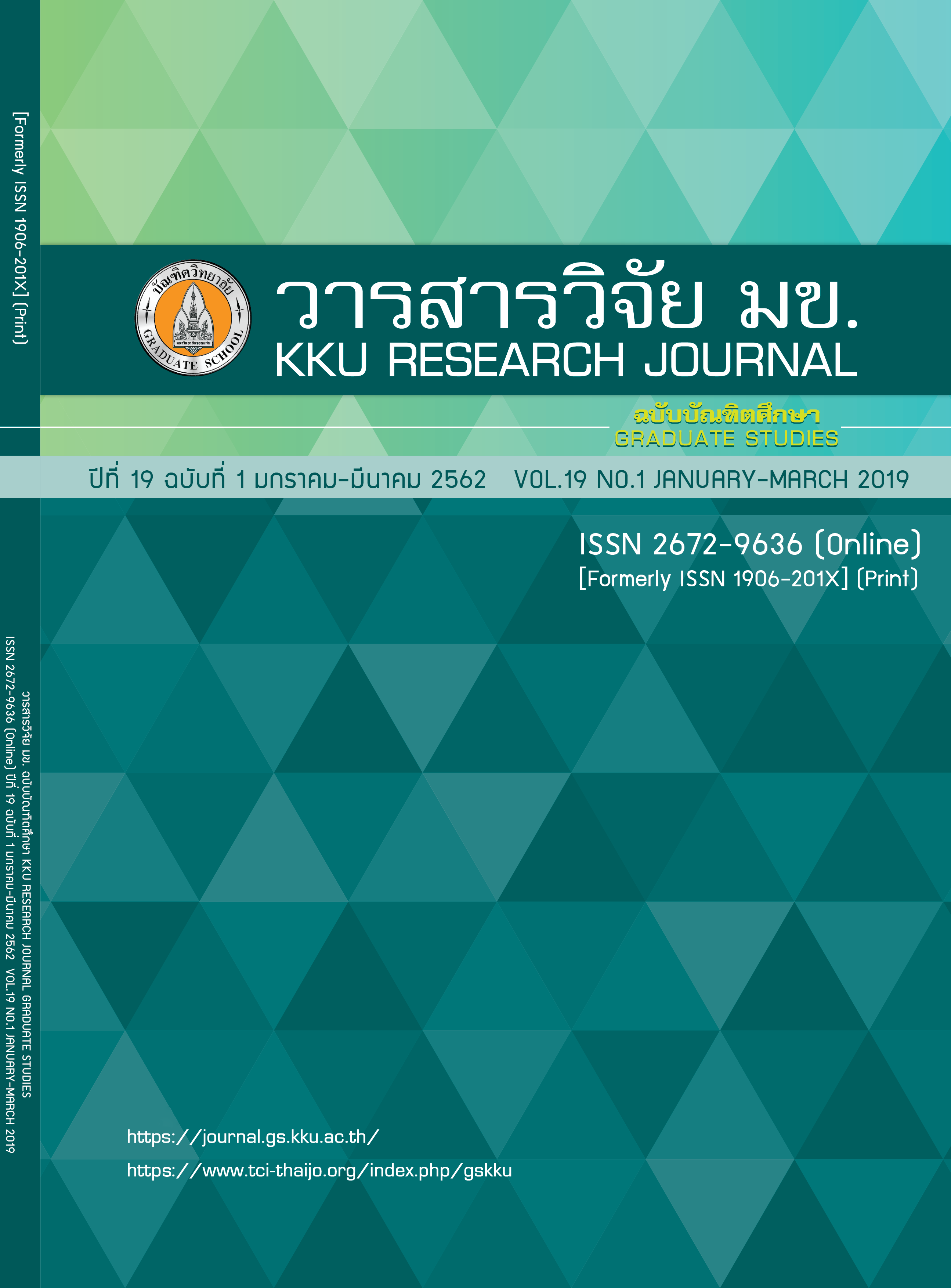สมรรถภาพกายและหน้าที่การทำงานของหัวใจและปอดหลัง 12 สัปดาห์ ของการฝึกโปรแกรมยูชิโกมิร่วมกับการเพิ่มน้ำหนักที่แขนและขาในนักกีฬายูโดไทย
คำสำคัญ:
โปรแกรมการฝึกยูชิโกมิ, สมรรถภาพกาย, หน้าที่การทำงานของหัวใจและปอดบทคัดย่อ
ยูโดเป็นรูปแบบศิลปะการต่อสู้ที่เป็นที่นิยมและมีในการแข่งขันกีฬาโอลิมปิก เป็นกีฬาที่ค่อนข้างมีประวัติอันยาวนาน นอกจากจะเป็นศิลปะการต่อสู้ที่เป็นที่นิยมแล้วยูโดยังเป็นกีฬาต่อสู้อีกด้วยวัตถุประสงค์ของการวิจัยเพื่อศึกษาผลของการฝึก 12 สัปดาห์โปรแกรมการฝึกยูชิโกมิร่วมกับการเพิ่มน้ำหนักที่แขนและขาต่อ สมรรถภาพกายและหน้าที่การทำงานของหัวใจและปอดในนักกีฬายูโดไทย ในอาสาสมัครกลุ่มฝึกยูชิโกมิร่วมกับการเพิ่มน้ำหนักที่แขนและขา (N = 18) จะถูกฝึกโดยใช้รูปแบบการฝึกยูโดแบบปกติ (NJTP) 2 วันต่อสัปดาห์ และฝึกยูชิโกมิร่วมกับการเพิ่มน้ำหนักที่แขนและขา 50 นาทีต่อครั้ง (อบอุ่นกาย 10 นาที 30 นาที ฝึกโปรแกรมยูชิโกมิ ที่ระดับความหนัก 60 - 80 % ของอัตราการเต้นหัวใจสูงสุด (HRmax) คลายอุ่น 10 นาที) เป็นเวลา 3 วัน ต่อเนื่องกัน 12 สัปดาห์ ขณะที่อาสาสมัครกลุ่มควบคุม (N=17) จะถูกฝึกเฉพาะรูปแบบการฝึกยูโดแบบปกติ (NJTP) ผลการประเมินลักษณะพื้นฐาน พบว่าไม่มีความแตกต่างทางสถิติในกลุ่มควบคุมในขณะที่ในกลุ่มฝึกโปรแกรมยูชิโกมิพบความแตกต่างอย่างมีนัยสำคัญของ เปอร์เซ็นต์ไขมันในร่างกายเส้นรอบเอว (WC) เส้นรอบสะโพก (HC) และอัตราการเต้นของหัวใจ (HR) ผลของสมรรถภาพกายและข้อมูลของการทดสอบหน้าที่การทำงานของหัวใจและปอดพบว่ามีความแตกต่างอย่างมีนัยสำคัญทางสถิติที่ p<0.001 ภายในกลุ่มฝึกโปรแกรมยูชิโกมิ ในสัปดาห์ที่ 1, 7 และ 14 การศึกษานี้แสดงให้เห็นว่าการฝึกยูชิโกมิร่วมกับการเพิ่มน้ำหนักที่แขนและขาเป็นรูปแบบการฝึกซ้อมแบบใหม่ของยูโดที่เหมาะสำหรับการปรับปรุงสมรรถภาพกายและหน้าที่การทำงานของระบบหัวใจและปอดในนักกีฬายูโดไทย
เอกสารอ้างอิง
2. Detanico D, Dal Pupo J, Franchini E, dos Santos SG. Relationship of aerobic and neuromuscular indexes with specific actions in judo. Science & Sports 2012; 27: 16-22.
3. Almansba R, Sterkowicz S, Sterkowicz-Przybycień K, Comtois A. Reliability of the Uchikomi Fitness Test: A Pilot study. Reliability of the Uchikomi Fitness Test. Science & Sports 2012; 27: 115-118.
4. Almansba R, Parent AA, Boucher JP et al. Oxygen Uptake and Cardiopulmonary Demands of World Class Judoist performing the Uchi-Komi Fitness Test. In: 59th Annual Meeting of the American College Sports Medicine 2012; 782.
5. Pulsak S. A study of the center of gravity in Judo throwing. Bangkok: Thai Thesis Database; 1994.
6. Marx JO, Ratamess NA, Nindl BC, Gotshalk LA, Volek JS, Dohi K, et al. Low-volume circuit versus high-volume periodized resistance training in women. Medicine and Science in Sports and Exercise 2001; 33: 635-643.
7. Chumvangvapee P, Suttitum T, Pasurivong O, Piwngern T. A new exercise model: Brisk walking with swaying hips and hand weight load exercise program and its effect on anthropometry, physical performance and cardiopulmonary function in obese Thai adults.KKU Research Journal2016; 16: 63-74.
8. Forjaz C, Matsudaira Y, Rodrigues F, Nunes N, Negrão C. Post-exercise changes in blood pressure, heart rate and rate pressure product at different exercise intensities in normotensive humans. Brazilian Journal of Medical and Biological Research 1998; 31: 1247-1255.
9. Heyward VH, Gibson A. Advanced fitness assessment and exercise prescription 7thed: Human Kinetics; 2014.
10. Pathare N, Haskvitz EM, Selleck M. Comparison of measures of physical performance among young children who are healthy weight, overweight, or obese. Pediatric Physical Therapy 2013; 25: 291-296.
11. Roberts HC, Denison HJ, Martin HJ, Patel HP, Syddall H, Cooper C, et al. A review of the measurement of grip strength in clinical and epidemiological studies: towards a standardised approach. Age and Ageing 2011; 40: 423-429.
12. Judoinfo. Gripping [internet]. 2017 [cite 2017 June 9]. Available from: http: //judoinfo.com /gripping/
13. ACSM. American College of Sports Medicine Position Stand. The recommended quantity and quality of exercise for developing and maintaining cardiorespiratory and muscular fitness, and flexibility in healthy adults. Medicine and Science in Sports and Exercise 1998; 30: 975-991.
14. Jackson A, Langford NJ. The criterion-related validity of the sit and reach test: replication and extension of previous findings. Research Quarterly for Exercise and Sport 1989; 60: 384-387.
15. Brooks GA. Anaerobic threshold: review of the concept and directions for future research. Medicin and Science in Sports and Exercise 1985; 17: 22-34.
16. Santos E, Rhea MR, Simão R, Dias I, de Salles BF, Novaes J, et al. Influence of moderately intense strength training on flexibility in sedentary young women. The Journal of Strength & Conditioning Research 2010; 24: 3144-3149.
17. Borman NP, Trudelle-Jackson E, Smith SS. Effect of stretch positions on hamstring muscle length, lumbar flexion range of motion, and lumbar curvature in healthy adults. Physiotherapy Theory and Practice 2011; 27: 146-154.
18. Saraiva AR, Reis VM, Costa PB, Bentes CM, Costa e Silva GV, Novaes JS. Chronic effects of different resistance training exercise orders on flexibility in elite judo athletes. Journal of Human Kinetics 2014; 40: 129-137.
19. Aquino ES, Mourão FA, Souza RK, Glicério BM, Coelho CC. Comparative analysis of the six-minute walk test in healthy children and adolescents. Brazilian Journal of Physical Therapy 2010; 14: 75-80.
20. Piwngern T, Suttitum T, Khrisanapant W, Pasurivong O, Chumvangvapee P. The effect of Applied Sakon Nakhon Traditional Thai Boxing Dance on Physical Performance and Cardio-pulmonary Capacity in Thai Elderly Females.Srinagarind Medical Journal 2016; 31: 312-319.
21. Geiger R, Willeit J, Rummel M, Hogler W, Stubing K, Strasak A, et al. Six-minute walk distance in overweight children and adolescents: effects of a weight-reducing program. Journal of Pediatrics 2011; 158(3): 447-451.
22. Ulrich S, Hildenbrand FF, Treder U, Fischler M, Keusch S, Speich R, Fasnacht M. Reference values for the 6-minute walk test in healthy children and adolescents in Switzerland. BMC Pulmonary Medicine 2013;13-49.



